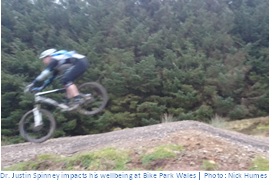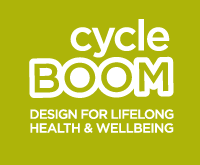 One of the challenges for the cycle BOOM team is identifying ways in which wellbeing whilst cycling can be represented.
One of the challenges for the cycle BOOM team is identifying ways in which wellbeing whilst cycling can be represented.
In pursuit of this, Justin Spinney and I attended the Ordnance Survey OpenData Masterclass hosted in the Cardiff University Engineering Department in November 2013. Here we learned about the potential of new open source (free) developer tools and their functionality. This did not only teach us how to use the software but provided further ideas on how we may access, query and graphically illustrate data trends pertinent to the cycle BOOM study. We recognise that communicating and presenting data will be just as challenging as collecting data but we came away from the event packed with useful ideas.
In early December we attended The Accessibility Symposium held at the University of London – where, as well as a guided tour of the PAMELA test laboratory at UCL, we listened to useful presentations that focused on methods of capturing information (e.g. crowdsourcing):
- Catherine Holloway (UCL), the event organiser, focused on developing technologies, tools and methods to better inform transport and health care policies.
- Louise Francis, from Mapping for Change, described several projects which have used crowd sourced information to inform policy as well as the use of publicly maintained online maps.
- Peter Jones, Professor of Transport at UCL, explained how the interaction of different levels of access could aid in providing better mobility. Peter emphasised that presenting research findings in a clear and digestible way is key to influencing policy.
These events allowed us to reflect, not only on the technical approaches to measuring and mapping movement in space but also how we conceptualise accessibility and mobility. Often we compartmentalise the issue of accessibility to those who are impaired or less ambulant than others. But this is incorrect. Accessibility affects us all whether we are navigating through a congested city, or trying to board a bus or train with an arm full of shopping. What the events have shown is that good design is key and should not just be reserved for showcase buildings and ‘coffee table’ magazines. One solution to this is inclusive design. This is a paradigm which promotes flexibility and accessibility through way-finding and legibility, lighting, acoustics, material and tactility, and by removing segregation and redundancy in design. There are three points I want to emphasise:
- Accessibility and inclusive design are not just for older or disabled people – the benefits of such ‘good design’ principles are experienced by all.
- Accessibility is not just about creating endless ramps and policy documents, it is about understanding users’ needs. Often the understanding that people don’t want to be treated differently is missing. This is emphasised through interventions such as access ramps which are located at the far end of a building or by separate sections for wheelchair users at football matches or concerts – quite often sitting with their friends and to be part of the crowd and experience the atmosphere just like everyone else is what is desired. This is of course where the challenge lies when designing the built environment.
- Designing inclusively does not mean that you should produce a boring or sterile design, there is nothing to stop the same joy of form and function, and inherent character that creates design icons, to be applied to schemes which aim to meet accessibility standards. Putting ‘inclusive design’ on a pedestal or as something different from ‘design’ does not help the situation as it immediately categorises it as something different from what designers normally do. Inclusive design is what we should be doing as standard: to design inclusively is to ‘Design’.
So what does this all mean for the cycle BOOM project? From what we have learnt, it is necessary to understand users’ needs and to take key design principles like ‘inclusive design’ and transpose and test them in the context of cycling, in order to provide findings which advocate cycling without alienating others. And what about the next step? During February, the Cardiff team will meet the Cardiff City Cycling Officer to investigate cycling policy and older people. We are also looking forward to attending the cycle BOOM team ‘methods’ workshop (6 and 7 February) at Oxford Brookes University. This will be an opportunity to share our ideas, test equipment and consolidate our approach, so that we will be in a position to start recruiting participants for mobile interviews in Spring 2014.
Nick Humes is a Research Assistant on the cycle BOOM research project at Cardiff University. Contact him at HumesN@cardiff.ac.uk

Leave a Reply